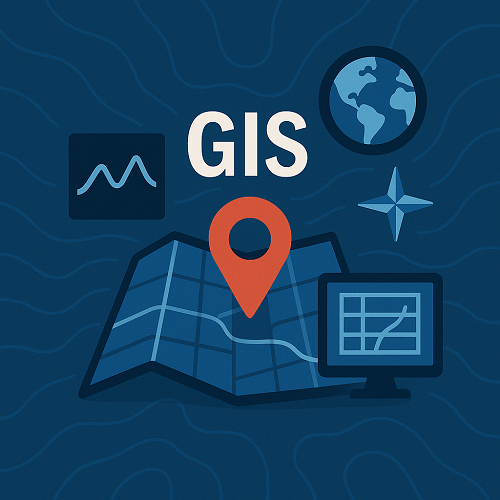TL;DR
- AI-driven automation now defines data collection and predictive spatial modeling.
- IoT and real-time sensor networks elevate GIS from static mapping to live monitoring systems.
- Blockchain is reinforcing trust with decentralized spatial records and improved data provenance.
- Virtual and augmented reality interfaces deliver immersive analytics and 3D visualization.
- Interoperability standards support secure collaboration across cloud-based GIS platforms.
What’s New Right Now
As GIS enters 2025, the technology is rapidly merging with intelligent automation. Artificial Intelligence (AI) enables superior spatial prediction models, while Internet of Things (IoT) integration provides real-time environmental monitoring. The move toward blockchain and decentralized data enhances transparency and accuracy. These developments point to a future of smart geospatial infrastructure and secure, connected ecosystems.
For instance, Esri has expanded its AI-powered analysis capabilities to support predictive urban design (source). Meanwhile, research on blockchain-GIS fusion has gained traction across academic institutions (source), signaling a decentralized turn in geospatial recordkeeping.
Why It Matters
For businesses, the evolving GIS ecosystem means better decision-making through real-time insights—vital for logistics, utilities, and urban planning. Technically, these advances establish a resilient data network, addressing scaling challenges and ensuring data verifiability. Organizations investing in interoperable platforms can streamline operations, reduce manual data errors, and meet compliance mandates more efficiently.
GIS professionals are focusing not just on maps, but on actionable intelligence linked directly to IoT sensor data, edge computing, and AI-assisted analytics. This integrated model opens doors to predictive maintenance, emergency response optimization, and sustainable smart city design.
Deep Dive: Transformative Trends Redefining GIS
1. AI and Machine Learning Integration
AI algorithms now automate feature extraction from satellite imagery, dramatically reducing processing time. Predictive modeling can identify land-use trends and even forecast urban expansion. This scalability empowers analysts to transition from reactive mapping to proactive spatial intelligence.
2. IoT-Driven Real-Time Mapping
IoT sensors continuously feed data to GIS dashboards, offering live environmental and infrastructure updates. In agriculture, soil humidity data merged with GIS improves irrigation efficiency. Transportation systems utilize GPS-linked IoT devices for fleet optimization and congestion management.
3. Blockchain for Data Integrity
Blockchain integration provides immutable ledgers for geospatial transactions and ownership validation. Land registry management, traditionally prone to data alterations, benefits from secure authentication layers. Decentralized GIS records are becoming foundational in transparent governance.
4. Immersive Analysis using Virtual and Augmented Reality
Virtual reality (VR) and augmented reality (AR) tools now empower planners to immerse themselves within spatial data. 3D viewing technologies permit interactive simulations, from flood modeling to infrastructure visualization—a step change for urban planning workflows.
5. Enhanced Interoperability and Cloud Integration
Interoperable frameworks allow diverse GIS systems to communicate seamlessly. With open standards from OGC (Open Geospatial Consortium), workflows can shift data among cloud services without sacrificing precision (source).
| Trend | Typical Use Case | Benefit |
|---|---|---|
| AI-Based Spatial Analytics | Predicting urban sprawl, natural hazard mapping | Faster and more accurate predictions |
| IoT Integration | Smart city monitoring and asset tracking | Real-time awareness and resource optimization |
| Blockchain GIS | Land ownership and environmental data verification | Tamper-resistant, transparent records |
| VR/AR Mapping | Infrastructure design visualization | Immersive insight and improved stakeholder engagement |
| Cloud Interoperability | Cross-platform data sharing | Efficiency and improved collaboration |
Mini Case Study: Smart Water Management Using Real-Time GIS
Problem: A regional utility in Europe faced inconsistent water usage data and delayed leak detection, risking both service reliability and environmental loss.
Approach: The utility implemented an IoT-linked GIS system tied to pressure sensors and flow meters across its network. AI models analyzed spatial patterns and flagged anomalies, while blockchain verified sensor data integrity.
Outcome: Within six months, the utility reported a 28% reduction in downtime and a 35% faster leak response rate. The secure, autonomous GIS infrastructure also supported transparent auditing, improving stakeholder trust and operational savings.
Implementation Checklist
- Assess data sources and define interoperability goals.
- Establish API connections between GIS and IoT sensors.
- Adopt AI-based spatial analysis tools for predictive modeling.
- Integrate blockchain modules for verifiable recordkeeping.
- Test VR visualization environments for complex spatial scenarios.
- Train staff on cross-platform GIS operations and data governance.
- Monitor real-time dashboards and iterate analytical models.
FAQs
1. How is AI improving GIS efficiency?
AI helps automate data classification, detect patterns, and improve spatial forecasting accuracy. Tasks once requiring days now finish in minutes.
2. Can GIS systems truly be decentralized?
Yes. Through blockchain storage and distributed ledgers, GIS data can be securely decentralized, improving authenticity and accessibility.
3. What industries benefit most from IoT-linked GIS?
Utilities, transportation, agriculture, and smart city initiatives see major gains from real-time spatial IoT insights.
4. Is immersive GIS visualization worth the investment?
For organizations handling complex spatial data—such as urban planners or disaster managers—VR/AR mapping drastically improves decision clarity.
5. How do businesses start integrating these technologies?
Begin with pilot projects combining existing GIS data with small IoT and AI modules, then expand gradually based on measurable ROI.
Conclusion
GIS in 2025 is not merely about mapping—it’s about intelligent spatial ecosystems linking AI, IoT, and secure data architecture. As real-time insights and decentralized governance reshape geospatial analysis, organizations can drive efficiency, transparency, and innovation across sectors. To harness these evolving capabilities, explore our GIS services and prepare your enterprise for the next frontier of geospatial intelligence.
